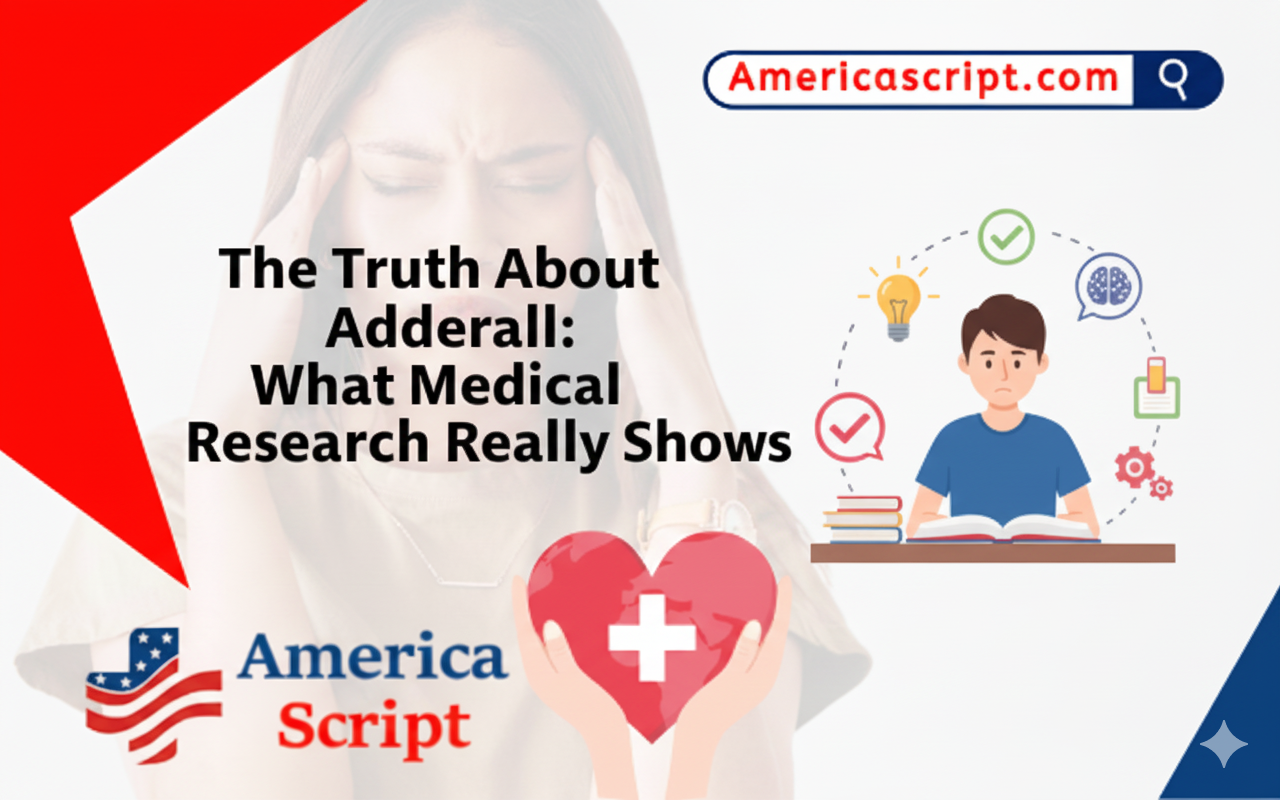The Truth About Adderall: What Medical Research Really Shows

Adderall ranks as the fifteenth most commonly prescribed medication in the United States, with doctors writing more than 32 million prescriptions in 2023 alone. Despite this widespread use, many people still wonder what is Adderall and why it carries both medical benefits and serious risks. As a Schedule II controlled substance, its potential for misuse deserves our attention, especially considering that 5.1 million people aged 12 or older misused prescription stimulants like Adderall in 2020.
The rising trend of Adderall misuse is particularly concerning among college students. In fact, nonprescription stimulant use has surged over the past decade, becoming second only to marijuana as the most common form of illicit drug use in college populations. Throughout this article, we’ll explore what Adderall does in the body, what Adderall is used for medically, and the documented side effects of Adderall. We’ll also examine what research reveals about Adderall’s effects on people without ADHD and the potential consequences of misuse that can include serious health risks like myocardial infarction or even sudden death.
What is Adderall and what is it used for?
Adderall combines two active ingredients – amphetamine and dextroamphetamine – forming a potent central nervous system stimulant. These compounds work by increasing levels of dopamine, norepinephrine, and serotonin in the brain. For individuals with ADHD who typically have lower dopamine levels, Adderall helps transition the brain from overstimulation to normal stimulation.
The FDA has approved Adderall primarily for two medical conditions. First, it treats Attention Deficit Hyperactivity Disorder (ADHD) in both children and adults. When used for ADHD, Adderall decreases impulsivity while promoting increased attention and focus. Additionally, doctors prescribe it to treat narcolepsy, a sleep disorder characterized by excessive daytime sleepiness.
Click Here To Buy Adderall Online
Adderall comes in two distinct formulations. The immediate-release (IR) tablet typically works for 4-6 hours, requiring multiple daily doses. Conversely, the extended-release (XR) capsule provides effects lasting 8-12 hours, allowing for once-daily dosing.
The medication works differently depending on the condition. For ADHD patients, Adderall provides relief from symptoms like inability to focus, restlessness, and impulsive behavior. For narcolepsy patients, it helps maintain wakefulness throughout the day.
Consequently, when prescribed appropriately, Adderall can significantly improve quality of life for those with these specific medical conditions.
Short-term and long-term effects of Adderall
When taken as prescribed, Adderall counteracts ADHD symptoms by increasing norepinephrine and dopamine availability in the brain, boosting alertness and attention. However, even therapeutic use comes with short-term side effects including appetite suppression, dry mouth, restlessness, and irritability.
Furthermore, Adderall can raise blood pressure and heart rate, potentially causing cardiovascular issues. A groundbreaking 2024 study revealed that young adults prescribed ADHD stimulants were 17% more likely to develop cardiomyopathy (weakened heart muscle) after one year and 57% more likely after eight years compared to non-users. Nevertheless, the overall prevalence remained relatively low at 0.72% after ten years.
Long-term use may lead to both physical and psychological dependence. Physical dependence occurs as the brain becomes accustomed to the drug, resulting in withdrawal symptoms upon cessation, including depression, increased appetite, anxiety, and fatigue. Psychological dependence manifests as compulsive use despite negative consequences.
Chronic Adderall abuse can cause more serious complications: erratic behavior, paranoia, malnutrition, and vitamin deficiencies. Moreover, some users experience abnormal heart rhythms, increased blood pressure, and elevated risk of heart attacks. At high doses, Adderall can induce seizures, psychosis, and stroke, particularly when combined with other substances.
Addiction, misuse, and what research says
Contrary to popular belief, nonmedical use of Adderall doesn’t appear to enhance academic performance in healthy individuals. Research suggests that nonmedical users typically have lower grade point averages than non-users. College students represent the highest-risk group, with nonprescription stimulant use prevalence ranging from 6.9% to 35.5% across different campuses.
Adderall misuse often signals broader substance use issues. Studies reveal nonmedical stimulant users are more likely to meet criteria for alcohol and marijuana dependence. Beyond seeking academic advantages, many students use these drugs to enhance partying experiences or cope with educational stressors.
The notion that Adderall makes healthy people “smarter” lacks scientific support. Although the drug increases focus in ADHD patients, research indicates performance improvements in healthy individuals are highly variable and may actually deteriorate when baseline cognitive functioning is already optimal.
Prescription stimulant misuse creates significant risks. Users can develop tolerance within just one week, alongside potential withdrawal symptoms including:
- Severe depression and fatigue
- Sleep disturbances and nightmares
- Intense cravings and irritability
Rather than dismissing nonmedical use as benign, experts view it as a serious “red flag” potentially indicating other substance abuse problems, poor academic performance, or underlying mental health issues.
Conclusion
Adderall clearly serves a vital purpose for those with diagnosed ADHD and narcolepsy when prescribed appropriately. Nevertheless, the research paints a concerning picture regarding its misuse, particularly among college populations. Despite widespread misconceptions, evidence consistently shows that healthy individuals gain little cognitive benefit from nonmedical use while facing substantial health risks.
The dangers extend far beyond the immediate side effects. Actually, both short and long-term consequences can be severe, including cardiovascular complications, dependency, and potential psychological disturbances. Most compelling evidence suggests that nonmedical users often experience lower academic performance rather than the enhancement they seek.
We must recognize that Adderall misuse frequently indicates broader substance use problems rather than simply representing an academic performance strategy. The misconception that it makes healthy individuals “smarter” lacks scientific backing, while the risks of dependence, tolerance, and withdrawal remain undeniably real. Click Here To Buy Adderall Online
Though Adderall continues as one of America’s most commonly prescribed medications, understanding the difference between therapeutic use and misuse becomes essential. The significant increase in cardiomyopathy risk over time underscores the importance of medical supervision, even for legitimate users.
Above all, these findings highlight why we should approach Adderall with caution and respect for its powerful effects on the brain and body. The truth about this medication lies not in campus rumors or social media claims but in the medical research that continues to reveal both its therapeutic benefits and serious potential harms.
FAQs
Q1. What are the potential long-term health risks associated with Adderall use?
Ans.Long-term Adderall use can lead to various health risks, including cardiovascular issues like increased risk of cardiomyopathy, potential damage to nerve cells, and psychological effects such as dependency and withdrawal symptoms. Chronic use may also cause erratic behavior, paranoia, and nutritional deficiencies.
Q2. How does Adderall affect the body when used as prescribed?
Ans. When used as prescribed for ADHD or narcolepsy, Adderall increases levels of dopamine, norepinephrine, and serotonin in the brain. This helps improve focus, reduce impulsivity, and maintain wakefulness. However, even therapeutic use can cause side effects like appetite suppression, dry mouth, and increased heart rate.
Q3. Can Adderall improve cognitive performance in people without ADHD?
Ans.Contrary to popular belief, research shows that Adderall does not significantly enhance cognitive performance in healthy individuals. In fact, nonmedical users often have lower academic performance compared to non-users. The drug’s effects on healthy people are highly variable and may even deteriorate performance when baseline cognitive functioning is already optimal.
Q4. What are the signs of Adderall addiction or dependence?
Ans.Signs of Adderall dependence can include developing tolerance, experiencing withdrawal symptoms when not using the drug, and compulsive use despite negative consequences. Withdrawal symptoms may include severe depression, fatigue, sleep disturbances, intense cravings, and irritability.
Q5. Is there new research about Adderall’s effects on heart health?
Ans. Yes, a 2024 study revealed that young adults prescribed ADHD stimulants like Adderall had an increased risk of developing cardiomyopathy (weakened heart muscle). The risk was 17% higher after one year of use and 57% higher after eight years compared to non-users, although the overall prevalence remained relatively low.
Get Flat 10% Discount on All Medicines. Use Coupon Code – SALE10 Visit – americascript.com


